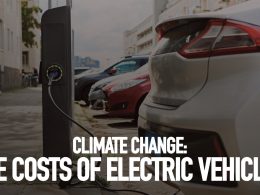By Connor Rosoman & Philipp Chmel, International Socialist Alternative
In the light of exacerbating climate crisis and absolute inaction of capitalist governments, the climate movement is testing out and adapting its tactics and strategies across the globe including with school occupations, blockades, and building joint campaigns with workers as well as supporting their strike actions by joining the picket lines.
Extinction Rebellion turns to the labour movement?
On the weekend of 20–22 April, up to 60,000 people descended on London as part of ‘The Big One’ — a 4-day series of protests organized by climate activist organization ‘Extinction Rebellion’ (XR). They were joined by trade unions such as the Public and Commercial Services union (PCS), feminist organizations, refugee rights groups and many more — including Socialist Alternative — in a broad mobilization against the increasingly present threat presented by the climate emergency.
This weekend of action marked a change of tactics for XR — from a previous focus on action like roadblocks and occupations toward mass protests based on “building collective power, strengthening in number and thriving through bridge-building”.
This comes at the same time as mass struggle has taken on a renewed importance around the world — primarily in the form of mass strike waves of workers against the cost of living crisis. XR themselves have clearly taken note of the strikes, and the methods of collective struggle they represent, which have drawn millions of working-class people into the fight to defend our standard of living.
In the run-up to ‘The Big One’, XR has organized alongside striking workers, for instance in Coventry, UK, where they organized a rally in solidarity with Amazon workers taking unofficial strike action. The vocal support for the strikes has also been reflected in XR’s plans for what comes next following ‘The Big One’ — emphasizing “people’s pickets” alongside the unions and building for further protests alongside other organizations.
Climate struggle is class struggle
It is no surprise that the strike wave sweeping many countries since 2022 has had an influence on the ideas of other groups like Extinction Rebellion. By collectively withdrawing our labour — the most powerful tool we have as a class — workers have set a historic example by forcing big business to the negotiating table.
The strikes have also seen wide public support. In Britain, for instance, polling in January showed majority support for striking healthcare workers, as well as strong support for other sectors such as teachers. This is because not only are these workers rightfully fighting back against the cost of living crisis all working-class people are feeling the effects of, but in many cases these strikes represent a fight to defend public services too. Among a wide layer of politically-engaged working-class people, it is understood that the strikers are fighting “for all of us”. This idea is true of the climate struggle too — and building connections with the strikes has the potential to strengthen both movements.
It is not just in the UK that we see links being drawn between the climate movement and the other struggles of working class people.
In Austria, as we reported before, “activists from System Change not Climate Change and Fridays for Future supported the striking rail workers in their fight for higher wages” in November 2022 and the group System Change not Climate Change now calls for solidarity with the strikes in the adult education sector.
In Germany, Fridays for Future and the trade union ver.di have joint forces for the campaign #wirfahrenzusammen (“we ride together”). They demand massive investments in public transport to double its capacity by 2030 and higher wages for workers in the sector. Fridays for Future states that investments are specifically needed to guarantee “better working conditions in public transport; more staff to relieve pressure; affordable tickets; expansion of route networks & higher frequency”. At the last global climate strike on March 3 2023, public transport workers joined climate activists in the streets in over 40 cities. The union ver.di called for a nationwide day of action and in six federal states also for warning strikes. In turn, Fridays for Future supported the “Mega-Streik” in the transport sector on March 27 called for by the unions ver.di and EVG (“railway and transport union”) and joined workers going on strike in more than 20 cities.
That the workers and climate movement need to fight together to win is also recognized by the ruling class. An article in the left-liberal newspaper Süddeutsche Zeitung claims that by striking together, ver.di and Fridays for Future would actually destroy the transformation to sustainable mobility and would harm the climate and counters the groups’ call to join the struggle for climate and social justice with the argument that those would be naturally opposed to one another as financial resources are limited. The Chief Executive of the Confederation of German Employers’ Associations is also not amused, he calls the collective action of climate groups and unions a “dangerous transgression”. These reactions show that this is exactly the right strategy and that we need to redouble our efforts in this direction.
In France, where millions of workers and youth have joined the movement against Macron and his pension reform, the climate and workers’ movement are also joining forces in several instances. The most prominent one is the struggle around the mega-basins at Saint-Soline; water storage projects that are planned to secure irrigation for large-scale agri-business at the expense of smaller farmers and the environment. If successful, public money would be used to “organize the privatization of water for the benefit of a minority” as the CGT union states. Together with the union Solidaires 79 they registered the protests against the project in October 2022, both unions were also present at the 30,000 strong demonstration on March 23 this year, which was heavily attacked by police.
Trade union groups from CGT and Solidaires alongside La France Insoumise and others on the left have also supported the call for mobilization against the expansion of the highway A69 in southern France. Over 8,000 people joined the action and together they not only occupied the highway, but built an actual concrete block wall across it.
When social and class struggles increase in intensity and strong movements develop, the working class tends to get more united, joining forces in struggle and more and more people become conscious that the repressive capitalist state and system is the common enemy.
This is also expressed in slogans such as “Neither at 64, nor A69”, on banners during the May 1 demonstrations that called for solidarity with the victims of police violence at the recent environmental and pension reform protests and explicitly in statements from the union Solidaires that writes “our social and ecological struggles are closely linked and must be interwoven. This is the meaning of the trade unionism of social transformation” or Les Soulèvements de la Terre (“The Uprising of the Earth”): “Let’s fight together against this system that forces us to wear out our bodies at work for two more years to enrich a minority; this system that has only production and growth as a perspective, while the land is disappearing, while water is already lacking”.
Direct action
These recent struggles highlight the potential for a broad-based climate movement making links with other sections of working-class people. They mark in many ways a harkening-back to the kinds of methods that were beginning to be explored by the renascent climate movement in 2018/19 following the landmark school strikes organized by Fridays For Future. At the height of the movement, workers’ organizations, parents and other groups were just beginning to form an important part of the demonstrations.
Unfortunately since the re-opening of society following the pandemic, we have not seen the resurgence of protests on this level. Meanwhile, the ecological crisis has only gotten worse. Despite acknowledging the climate emergency in words, governments around the world have continually failed to take any serious action on the climate. CO2 emissions continue to rise, and billions that could be spent on green jobs, retrofitting houses, public transport or fulfilling pledges to support the neocolonial world against the worst effects of climate change have been spent on arms races as part of the New Cold War.
In light of these overlapping crises and the complete inaction and inability of governments to solve them, a growing number of activists have been resorting to smaller-scale direct action and sabotage — with the aim of forcing the hands of governments and corporations by shutting down fossil infrastructure such as roads, coal trains or private jet terminals. In a similar vein, German climate activist group Letzte Generation (Last Generation) blocked dozens of streets throughout Berlin to ‘grind the city to a halt’ in April and student climate activists around the banner of End Fossil: Occupy! have launched the second round of school and university blockades and occupations on May 2.
Related to this, we have seen bold, attention-grabbing actions to shine a light on climate inaction. This would include Just Stop Oil’s now-famous stunt at London’s National Gallery, where soup was thrown at Van Gogh’s Sunflowers and many actions targeting buildings of luxury brands with washable paint.
Ideas of sabotage and direct action were also laid out in Swedish author Andreas Malm’s ‘How To Blow Up a Pipeline’ which made ripples in climate activist circles upon its release in 2021, and coincided with the ongoing rise in direct action climate groups. In the book, Malm highlights the importance of such tactics, in the context of the wider climate movement, as part of a “radical flank” that can support the fight for reforms, and also pointing toward recent sabotage movements as the way forward for climate struggle. Malm makes the point that the ruling class can’t be trusted to act now against this crisis, saying: “if we let the dominant classes take care of this problem, they’re going to drive at top speed into absolute inferno”. In this sense, he is totally correct.
In the same vein, Groups like Just Stop Oil and Insulate Britain also argue for their continuation of ‘disruptive’ action in contrast to XR’s change of tactics: “In the UK right now, nurses, ambulance drivers and railway workers are on strike because they understand that public disruption is vital to demand changes that governments are not willing or are too scared to address.”
This is why building a mass movement that can fight to win immediate change to defend the climate and our living standards, even against the resistance of the ruling class, is essential.
Revolutionary mass movement
It is true that direct actions can play a role in such a movement. Indeed, direct action tactics, including the blocking of roads, forms an important part of struggles of working class and oppressed peoples around the world, including workers’ struggles in India, and the struggle for indigenous rights in countries including Brazil and Canada. In these contexts however, the direct actions are usually connected to larger movements, which not only guarantees stronger support from the wider working class, but also makes them a lot more effective. This connection as well as involving larger groups of people in the concrete actions are also the best method to fight back against increasing state repression — in many countries laws are being prepared or have been passed that further criminalize direct action climate groups and protests — and the attempts by the ruling class to divide the “good” from the “bad” climate activists and stir up public contempt against climate activists by portraying them as “climate terrorists”. The above mentioned protests against the highway expansion in France are a case in point.
The capitalist system will seek to maintain its drive for profit no matter what. It is for this reason that the NGO-style tactics of merely trying to keep ‘raising awareness’ of the crisis or call out the inaction of governments is not enough. But we can win concessions if we fight for them. To do that we need action on a scale that can confront the massive industries exploiting people and the planet — and the national governments that represent them. The organized working class, in their thousands and their millions, can do this in a way no other form of action can by posing the possibility of shutting down whole industries — even the whole capitalist economy. In this way, a mass movement based on the power of workers’ strikes as its backbone can be built on the positive elements of both disruptive direct action and mass street protests and thereby also surpassing many of the limitations disruptive direct actions or street protests are confronted with if they are “on their own”.
But whatever hard-fought gains we win, as long as we leave society in the hands of the capitalists, these gains will always be limited and under attack. Big business and pro-capitalist politicians will do everything they can to get out of pledges and reverse any reforms.
Even with Trump out of office (undoubtedly a gain for the climate movement and for the planet as a whole), the US ruling class have forged ahead with destructive fossil fuel projects, which actually rose by 34% under Biden in his first year. After significant lobbying from fossil fuel companies, and corporations like Apple and Disney, and supported by the efforts of right-wing Democrats, the climate pledges in Joe Biden’s Inflation Reduction Act were watered down beyond recognition. And COP27 last year in Egypt was full of oil and gas companies defending their interests directly alongside capitalist world leaders.
This is why, within the broader climate movement, ISA fights to build a revolutionary socialist wing. It is not enough to settle for being a “radical flank” that can help the wider movement win changes within the system, as Malm and some others argue. We fight for revolutionary ideas to be taken on in the movement as a whole, to build a mass movement to make the demand for “system change not climate change” a reality.
What next?
Following on from April’s demonstrations, the question that needs to be asked is “how can a new, mass, revolutionary climate movement be built?”. XR’s own plan offers a good start. By organizing a campaign of “people’s picket” visits to the picket lines of striking workers, the links between the two movements can be deepened in a lasting way, and lay the ground for further mass demonstrations and actions, connected to the strikes. This would be a huge step forward.
ISA has been active in many countries over the last year in mobilizing solidarity visits from working-class people to picket lines, including alongside Enough is Enough in Britain and Workers Strike Back in the US. There is large potential to organize many more people to take part in climate actions and in solidarity actions with striking workers than have done so already. According to an online poll by XR on what actions people are ready to take that was answered by thousands of activists that participated at “The big one” in London, 91% said they would mobilize people around them to join climate actions and 47% are ready to support workers on strike and join them on the picket lines.
Taking our solidarity to the next step will mean using these visits and the links that can be built between trade union and climate activists to begin drawing up combined demands around jobs and the climate that can draw the two movements closer in struggle together. The joint campaign of unions and climate activists in Germany is a good first step. In addition to more funding, higher wages and better working conditions demands around nationalization of the key sectors of the economy and workers’ control need to be discussed. The fact that the growing cooperation and collective actions of the climate and the workers’ movement are developing alongside the ongoing class struggles offer the important possibility to make such discussions very concrete. The “Robin Hood” actions in France for example are a powerful illustration of what a society led by the working class could look like. Striking energy workers impressively demonstrated what working-class power and control over private production can achieve. They democratically decided to place hospitals, public sports centres, libraries, high schools, nurseries and low-income and social housing on free electricity or gas, re-established the distribution to users who had been cut off because of unpaid bills and offered a reduced rate of up to 60% for small traders, who received no comparable help from the government in the face of soaring prices.
The ongoing and by now longest factory occupation in Italy at the former GNK plant against job loss and for a transformation of production is another powerful example. The struggle started in July 2021 after the 422 auto parts workers were fired abruptly. Since then, they have built a powerful struggle against job loss and for “the reconversion toward sustainable mobility and renewable energy” that has been supported by a variety of feminist and climate groups in various ways including with several large demonstrations of up to 25,000. This evokes memories of the struggles for the conversion of the arms industries in the 1970s at Lucas Aerospace in Britain and in the 1980s at over 40 West German companies. The movement at the German companies went even further than the struggle at Lucas Aerospace. Demands for alternative production were combined with demands for regional and national employment programs, democratic decision-making structures in regional economic policy and the implementation of sectoral workers’ councils.
These points are crucial. The fight for public ownership and workers’ control needs to go beyond a single company and be aimed at entire sectors, since a collectively or publicly owned company within the capitalist market would still have to “compete with the private companies and quickly risks adopting the same commercial profit logic”.
Since big business and capitalist politicians are incapable of implementing the changes that are necessary, as those go against the very pillars of capitalism — we must fight for change ourselves.
Ultimately this means workers taking industry into our own hands, but this will only be possible if we can build a mass movement of working class people, with a fighting programme of demands to link the fight against the climate crisis to the struggle against the cost of living crisis, low wages, privatization and other struggles taking place. Such a programme would open the possibility for stronger united action, make concrete victories possible, and lay the basis for overthrowing the capitalist system that is destroying the planet.
Such demands could include:
- No to all new oil, coal and gas projects! We need massive investments into affordable and sustainable public energy production to cut emissions and end energy poverty. Let’s build a united front of the climate and workers’ and trade union movement to fight for well-paid jobs and good working conditions in sectors that really benefit society and protect the planet.
- For massive public investment in services, housing and infrastructure to stop emissions and to protect us against climate related disasters. We need more, better & free public transport in both urban and rural areas!
- Tax the super-rich and corporations to invest in green technology, energy and jobs.
- Stop pipeline projects, deforestation and imperialist exploitation of natural resources while ensuring the needs and rights of Indigenous and other communities as well as a job guarantee for all workers.
- Build coordinated protests and strikes by workers and students to paralyze the economy and force real changes.
- Nationalize the key sectors of the economy with democratic workers’ control and planning to ensure immediate changes in all major industries, and reorganize the economy to serve people and the planet.
- International workers’ solidarity instead of capitalist nationalist rivalry! Build the movement across all borders — there are no national solutions. The climate crisis is being weaponized by imperialism and the US and China in their great power rivalry. We say no to the New Cold War.
- As a result of immense global inequality, poorer countries currently bear the brunt of the climate crisis. To take first steps against this enormous injustice, all foreign debts must be cancelled and patents on crucial technology and knowledge scrapped. This can only be won through coordinated action by the international working class and poor for global revolutionary change and against national capitalist elites that defend their own interests.
- For socialist change to fight climate change!












